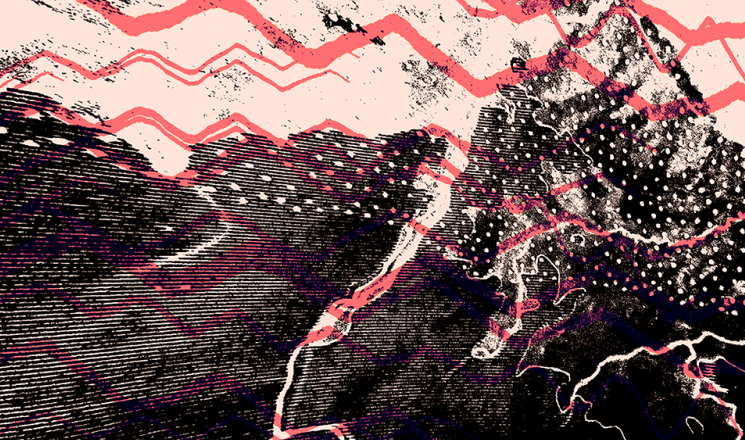Evolutionarily speaking, 4.6 billion years ago, the Earth, Gaia, meaning ‘land’ or ‘earth,’ came into being. For a few billion years, not much happened: water, lava gases, oxygen here, single-celled life there, and a bit of photosynthesis kicking in. But that all changed about 1 billion years ago when, according to geologists, the history of the Earth’s continental crust began. Land cracked and bubbled its way together in the name of Rodinia.
Fast forward a few hundred million more years, past the evolution of multicellular life and a biological big bang known as the Cambrian explosion, when the earliest plants and small creatures exploded into a complex array of kingdoms and taxonomic ranks that still stand today. They say Pannotia, a supercontinent that may or may not have formed near the South Pole about 600 million years ago, was born. It’s fair to consider this since all those new little animals and plants needed some dry land to rest their soggy feet.
You may be wondering, what does this have to do with the Scenic Rim? Well, it was during this 600-200 million years ago period that the ancient supercontinent Gondwana, named after the Gond people in India, was formed. And it was in this period that the first key ingredient to our Scenic Rim was born. Dense forest blanketed this land, encompassing no less than India, South America, Africa, Arabia, Madagascar, Antarctica, and Australia all in one. High up in that dense forest grew Antarctic Beech trees from Antarctica all the way up the landmass to what we now know as South East Queensland. Their ancestors still remain inside the Scenic Rim above 800-100m sea level today. Binna Burra is the most northern occurrence of the Antarctic Beech in the world—a place where the beech tree thrives. They survived because they were not wiped out by our second key ingredient to the Scenic Rim, lava, but we’ll come back to that.
Skipping ahead another few hundred million years, the supercontinent got even bigger, now known as Pangaea. Though it presented extreme climatic events due to its sheer size, swaying the Earth like the contents of a snow globe, it ended in the largest mass extinction the Earth has ever known. Most agree it was caused by a mass volcanic event that darkened the skies, cooled the climate, and caused ecosystems to collapse. But much survived, including the Gondwana landmass after it broke apart 180 million years ago, and a lot more was to come. Enter the dinosaurs with their protective shields!
By 85 million years ago, Gondwana still consisted of Antarctica and Australia, until finally, as supercontinental drift tends to do, Australia broke away and continues to drift north at a cracking pace of 7cm per year on a collision course towards Asia. Herein lies the moment, a few million years give or take, that we can return to our second ingredient of the Scenic Rim: lava. All this drifting and swaying caused by a floating Sahul was like playing “floor is lava,” quite literally, with the mantle deep below the Earth’s crust. It was only a matter of time before a random slight change in direction and a little pause over a rather volcanic hotspot would conjure up an extraordinarily volatile pressure valve over a dormant mountain range. And bang! 20 million years ago, the whole area blew its top, spewing out lava and settling into a tiny fraction of its former height as a remnant central plug: Wullumbin (Mt. Warning) was born. The caldera left by the eruption is the Scenic Rim.
Indeed, the area stretching from Lismore in the south to Tamborine in the north, and the coastline extending from Jullurgel (Burleigh Heads), has been shaped by geological processes and the eruptions of lava over three million years. These volcanic activities have played a significant role in the formation of the Scenic Rim. The diverse geological makeup of the landmasses, along with erosion rates, has contributed to the unique features of the region.
After the volcanic eruptions, the landscape settled, giving rise to what is now known as the Green Cauldron. The fertile red soil, lush rainforests, ancient trees, and natural beauty that characterize the Scenic Rim are all products of this geological history. The area has become a rich ecological wonder, recognised as one of the world’s most remarkable natural environments.
As for Sahul, the landmass that once connected Australia and Indonesia, it underwent various changes due to multiple ice ages and significant climatic events over millions of years. The northward drift of the landmass resulted in a warmer and drier climate, leading to the development of Australia’s dry-adapted flora we see today, dominated by acacias and eucalypts. During the past 100,000 years or so, a land bridge known as the Sunda existed between Australia and Indonesia, with intermittent straits separating the two regions. Along this shallow sea crossing, a remarkable human migration took place. It is believed that a small group of humans, potentially fewer than 100 individuals, strategically navigated, paddled, and planned their way to the continent we now call Australia. These early human settlers arrived in Australia and made it their home.
Despite the arrival of another group of humans approximately 200 years ago, the rugged topography of the Scenic Rim helped protect Australia’s largest expanses of subtropical rainforest from extensive clearing. These forests, collectively known as the Gondwana Rainforests of Australia, have been recognised by the United Nations as a World Heritage Area. This designation acknowledges the exceptional value and significance of these rainforests in terms of their ecological importance and evolutionary history.
But happened next? Read how the story unfolds across three of our key Heart & Lava destinations:




Written by Heart & Lava co-founder, Dr. Tristan Schultz
Sources:
Queensland Government Parks and Forests
University of Queensland Scenic Rim
Yale: Pannotia: A supercontinent on trial
National Geographic Permian Period
Britannica: Gondwana
Geological Site of NSW: Wollumbin